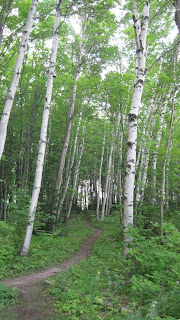

The white birches this time of year, with the contrast of the forest greenery, also makes for a nice shot.

As many tourists who come to the Lake Superior shoreline know, when the wind is from the south, the flies come out. They were biting my ankles so I wrapped one ankle with a towel and the other with an extra shirt. Other than the flies, it was great hanging out on the sandstone ledge.

Here are the shots I took of some of the plants growing along the creek next to the sandstone shelf.



There are several types of sandstone that make up the Pictured Rocks National Lakeshore. The oldest is called Jacobsville Sandstone, which was formed around a billion years ago. It is 500,000,000 years older than the other sandstones including the Munising and Au Train formations. Jacobsville sandstone quarrying began in 1883 in various sites, but especially in the Keeweenaw Peninsula where outcroppings also exist. Huge quantities of the distinctive red sandstone slabs were quarried over the years. The sandstone may also be striped, dotted, and spotted, depending on whether chemicals that repelled the red iron were also in the water that leached through the sandstone as it was being formed. Most stone was shipped to Marquette and transported by rail as far away as New York City. Nearby, Calumet, Hancock, and Houghton have many impressive buildings of Jacobsville sandstone. By 1900, the dark rich, colors of Jacobsville sandstone were becoming unfashionable. Influenced by the classic revival and Chicago's "White City" world's fair of 1893, architects came to prefer the whites and beiges of Indiana limestone




No comments:
Post a Comment